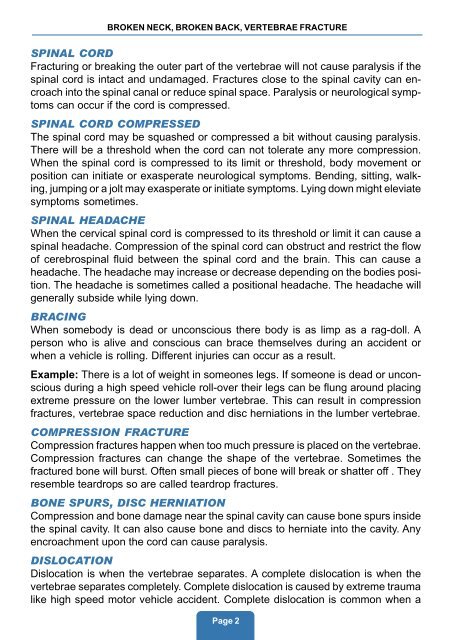broken neck, broken back, vertebrae fracture
broken neck, broken back, vertebrae fracture
broken neck, broken back, vertebrae fracture
Create successful ePaper yourself
Turn your PDF publications into a flip-book with our unique Google optimized e-Paper software.
BROKEN NECK, BROKEN BACK, VERTEBRAE FRACTURE<br />
SPINAL CORD<br />
Fracturing or breaking the outer part of the <strong>vertebrae</strong> will not cause paralysis if the<br />
spinal cord is intact and undamaged. Fractures close to the spinal cavity can encroach<br />
into the spinal canal or reduce spinal space. Paralysis or neurological symptoms<br />
can occur if the cord is compressed.<br />
SPINAL CORD COMPRESSED<br />
The spinal cord may be squashed or compressed a bit without causing paralysis.<br />
There will be a threshold when the cord can not tolerate any more compression.<br />
When the spinal cord is compressed to its limit or threshold, body movement or<br />
position can initiate or exasperate neurological symptoms. Bending, sitting, walking,<br />
jumping or a jolt may exasperate or initiate symptoms. Lying down might eleviate<br />
symptoms sometimes.<br />
SPINAL HEADACHE<br />
When the cervical spinal cord is compressed to its threshold or limit it can cause a<br />
spinal headache. Compression of the spinal cord can obstruct and restrict the flow<br />
of cerebrospinal fluid between the spinal cord and the brain. This can cause a<br />
headache. The headache may increase or decrease depending on the bodies position.<br />
The headache is sometimes called a positional headache. The headache will<br />
generally subside while lying down.<br />
BRACING<br />
When somebody is dead or unconscious there body is as limp as a rag-doll. A<br />
person who is alive and conscious can brace themselves during an accident or<br />
when a vehicle is rolling. Different injuries can occur as a result.<br />
Example: There is a lot of weight in someones legs. If someone is dead or unconscious<br />
during a high speed vehicle roll-over their legs can be flung around placing<br />
extreme pressure on the lower lumber <strong>vertebrae</strong>. This can result in compression<br />
<strong>fracture</strong>s, <strong>vertebrae</strong> space reduction and disc herniations in the lumber <strong>vertebrae</strong>.<br />
COMPRESSION FRACTURE<br />
Compression <strong>fracture</strong>s happen when too much pressure is placed on the <strong>vertebrae</strong>.<br />
Compression <strong>fracture</strong>s can change the shape of the <strong>vertebrae</strong>. Sometimes the<br />
<strong>fracture</strong>d bone will burst. Often small pieces of bone will break or shatter off . They<br />
resemble teardrops so are called teardrop <strong>fracture</strong>s.<br />
BONE SPURS, DISC HERNIATION<br />
Compression and bone damage near the spinal cavity can cause bone spurs inside<br />
the spinal cavity. It can also cause bone and discs to herniate into the cavity. Any<br />
encroachment upon the cord can cause paralysis.<br />
DISLOCATION<br />
Dislocation is when the <strong>vertebrae</strong> separates. A complete dislocation is when the<br />
<strong>vertebrae</strong> separates completely. Complete dislocation is caused by extreme trauma<br />
like high speed motor vehicle accident. Complete dislocation is common when a<br />
Page 2


